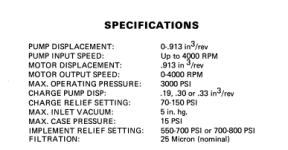KentT
Elite Member
- Joined
- Mar 31, 2005
- Messages
- 2,928
- Location
- Sevierville, TN
- Tractor
- 1993 Power Trac 1430 w/Kubota diesel engine
IMO, you're simply running into the limitations of the White RS wheel motors.
1. To quote White: RS Series motors are the most economical model in the White Drive Products product line.I know that when the original oil in my PT was hot, I could get it in situations where it simply would not move the PT, nor would it stall the engine. It would leak/bypass all the output of the tram pump. The PT would simply sit there and whine... Changing to AMSOIL syntheict 20W50 stopped that, and I could bog the engine down, but it still wouldn't climb out of some of the situations...
2. Most importantly, perhaps, are the basic specs of those 12.5ci motors. Under ideal conditions, no wear, the motors are only capable of producing 3050 in lbs (254 ft lbs) of torque at 1750 PSI, the max intermittent pressure the motor will handle, or 2640 in lbs (220 ft lbs) of torque at 1500 PSI, the max continuous PSI the motors will handle. That's the limits of the motors....
3. Then consider the tram pump itself -- I'm not certain of the specs for it, but I think it is a 2500 PSI, 16GPM pump -- which would actually exceed the power demand that the 25HP Kohler can produce, when combined with the PTO and steering/lift/tilt pump. I doubt you're ever spiking over 1500 PSI in a drive circuit, and likely running something like 1250 PSI normally. Bottom line is that you likely have wheel motors producing less than 200 ft lbs of torque -- with no other demands on the system (steering , PTO, etc.).
I can easily generate far more than 200 ft lbs of torque on my 1/2" breaker bar... no wonder this thing won't climb steep hills...
In comparison the 22.7 ci CharLynn S series motors that I put on mine can produce 390 ft lbs of torque at 1250 PSI (max continuous operating pressure) or 433 ft lbs of torque at 1500 PSI (max rated intermittent pressure). I ordered the optional high-pressure seals just to make sure the seals would handle those kinds of spikes, if necessary.
IMO, there's no substitute for displacement when it comes to torque....
1. To quote White: RS Series motors are the most economical model in the White Drive Products product line.I know that when the original oil in my PT was hot, I could get it in situations where it simply would not move the PT, nor would it stall the engine. It would leak/bypass all the output of the tram pump. The PT would simply sit there and whine... Changing to AMSOIL syntheict 20W50 stopped that, and I could bog the engine down, but it still wouldn't climb out of some of the situations...
2. Most importantly, perhaps, are the basic specs of those 12.5ci motors. Under ideal conditions, no wear, the motors are only capable of producing 3050 in lbs (254 ft lbs) of torque at 1750 PSI, the max intermittent pressure the motor will handle, or 2640 in lbs (220 ft lbs) of torque at 1500 PSI, the max continuous PSI the motors will handle. That's the limits of the motors....
3. Then consider the tram pump itself -- I'm not certain of the specs for it, but I think it is a 2500 PSI, 16GPM pump -- which would actually exceed the power demand that the 25HP Kohler can produce, when combined with the PTO and steering/lift/tilt pump. I doubt you're ever spiking over 1500 PSI in a drive circuit, and likely running something like 1250 PSI normally. Bottom line is that you likely have wheel motors producing less than 200 ft lbs of torque -- with no other demands on the system (steering , PTO, etc.).
I can easily generate far more than 200 ft lbs of torque on my 1/2" breaker bar... no wonder this thing won't climb steep hills...
In comparison the 22.7 ci CharLynn S series motors that I put on mine can produce 390 ft lbs of torque at 1250 PSI (max continuous operating pressure) or 433 ft lbs of torque at 1500 PSI (max rated intermittent pressure). I ordered the optional high-pressure seals just to make sure the seals would handle those kinds of spikes, if necessary.
IMO, there's no substitute for displacement when it comes to torque....

